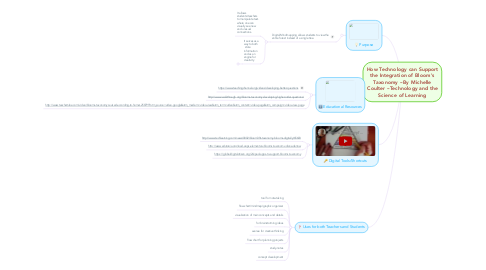How Technology can Support the Integration of Bloom's Taxonomy --By Michelle Coulter --Technology and the Science of Learning
by MICHELLE COULTER

1. Purpose
1.1. Digital Mindmapping allows students to view the entire forest instead of a single tree.
1.1.1. It allows students/teachers to manipulate text. where one can visually see new and unusual connections.
1.1.2. It serves as a way to both store information and as an engine for creativity
1.1.2.1. the mind maps doubles as a store of information and an engine of creativity
2. Educational Resources
2.1. https://www.teachingchannel.org/videos/developing-better-questions
2.2. http://www.iwalkthrough.org/blooms-taxonomy-developing-higher-order-questions/
2.3. http://www.teachertube.com/video/blooms-taxonomy-revised-according-to-homer-258799?utm_source=video-google&utm_medium=video-view&utm_term=video&utm_content=video-page&utm_campaign=video-view-page
3. Digital Tools/Shortcuts
3.1. http://www.techlearning.com/news/0002/bloom39s-taxonomy-blooms-digitally/65603
3.2. http://www.edutopia.org/ipad-apps-elementary-blooms-taxonomy-diane-darrow
3.3. https://globaldigitalcitizen.org/24-ipad-apps-to-support-blooms-taxonomy
4. Uses for both Teachers and Students
4.1. tool for note-taking
4.2. flow-chart/mindmap/graphic organizer
4.3. visualization of main concepts and details
4.4. for brainstorming ideas
4.5. avenue for creative thinking
4.6. flow chart for planning projects
4.7. study-notes
4.8. concept development


